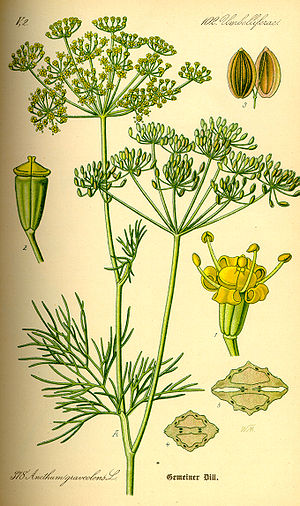딜
허브의 일종
딜(dill, Anethum graveolens)은 허브의 일종으로, 자라는 장소에 따라 여러해살이 허브, 한해살이 허브로 불린다. Anethum 속의 유일한 종이며, 시라(蒔蘿), 소회향(小茴香)으로도 부른다.
|
| |
|---|---|
 | |
| 생물 분류ℹ️ | |
| 계: | 식물계 |
| (미분류): | 속씨식물군 |
| (미분류): | 진정쌍떡잎식물군 |
| (미분류): | 국화군 |
| 목: | 미나리목 |
| 과: | 미나리과 |
| 속: | 딜속 |
| 종: | 딜 |
| 학명 | |
| Anethum graveolens | |
| L. | |
| 100 g (3.5 oz)당 영양가 | |
|---|---|
| 에너지 | 180 kJ (43 kcal) |
7 g | |
| 식이 섬유 | 2.1 g |
1.1 g | |
3.5 g | |
| 비타민 | 함량 %DV† |
| 비타민 A | 7717 (154%) IU |
| 티아민 (B1) | 9% 0.1 mg |
| 리보플라빈 (B2) | 25% 0.3 mg |
| 나이아신 (B3) | 11% 1.6 mg |
| 판토테산 (B5) | 8% 0.4 mg |
| 비타민 B6 | 15% 0.2 mg |
| 엽산 (B9) | 38% 150 μg |
| 비타민 B12 | 0% 0 μg |
| 비타민 C | 102% 85 mg |
| 무기질 | 함량 %DV† |
| 칼슘 | 21% 208 mg |
| 철분 | 51% 6.6 mg |
| 마그네슘 | 15% 55 mg |
| 망간 | 62% 1.3 mg |
| 인 | 9% 66 mg |
| 칼륨 | 16% 738 mg |
| 나트륨 | 4% 61 mg |
| 아연 | 9% 0.9 mg |
| 기타 성분 | 함량 |
| 구리 667 | 0.14 mg (7%) |
| †미국 국립학술원의 전문가 권고를 바탕으로 추정된 칼륨의 경우를 제외하고,[1] 모든 수치는 미국의 성인 권장량을 기준으로 한 추정치임.[2] | |
방향 효과
편집방향 효과는 다음과 같다.
독물학
편집독물학 분야에서의 향균 작용에 대한 설명은 다음과 같다.
- 황색포도상구균(Staphylococcus aureus)의 항균 작용[5]
- 사카로미세스 세레비시아(Saccharomyces cerevisiae)의 항균 작용[8][9]
쓰임새
편집처음은 약간 자극적이지만 바로 단맛으로 변하는 딜은 오이, 생선, 감자요리와 잘 어우러진다.[10] 잎, 줄기, 씨앗, 꽃 모두 활용할 수 있으며 생선이나 새우 등을 마리네이드 할 때나 소스를 만들 때 쓰인다.[10] 잎은 상쾌한 향을 살리기 위해 그대로 썰어 샐러드 등에 넣기도 한다.[10]
딜파우더는 통후추를 갈아서 사용하듯이 딜의 씨앗을 갈아서 사용한다.[10] 피클을 담글 때나 수프를 끓일 때 넣어 풍미를 더한다.[10]
각주
편집- ↑ National Academies of Sciences, Engineering, and Medicine; Health and Medicine Division; Food and Nutrition Board; Committee to Review the Dietary Reference Intakes for Sodium and Potassium (2019). 〈Chapter 4: Potassium: Dietary Reference Intakes for Adequacy〉. Oria, Maria; Harrison, Meghan; Stallings, Virginia A. 《Dietary Reference Intakes for Sodium and Potassium》. The National Academies Collection: Reports funded by National Institutes of Health. Washington, DC: National Academies Press (US). 120–121쪽. doi:10.17226/25353. ISBN 978-0-309-48834-1. PMID 30844154. 2024년 12월 5일에 확인함.
- ↑ United States Food and Drug Administration (2024). “Daily Value on the Nutrition and Supplement Facts Labels”. 《FDA》. 2024년 3월 27일에 원본 문서에서 보존된 문서. 2024년 3월 28일에 확인함.
- ↑ Bailer, J.; Aichinger, T.; Hackl, G.; de Hueber, K.; Dachler, M. (2001). “Essential oil content and composition in commercially available dill cultivars in comparison to caraway”. 《Industrial Crops and Products》 14 (3): 229–239. doi:10.1016/S0926-6690(01)00088-7.
- ↑ Santos, P. A. G.; Figueiredo, A. C.; Lourenço, P. M. L.; Barroso, J. G.; Pedro, L. G.; Oliveira, M. M.; Schripsema, J.; Deans, S. G.; Scheffer, J. J. C. (2002). “Hairy root cultures of Anethum graveolens (dill): establishment, growth, time-course study of their essential oil and its comparison with parent plant oils” (PDF). 《Biotechnology Letters》 24 (12): 1031–1036. doi:10.1023/A:1015653701265.[깨진 링크(과거 내용 찾기)]
- ↑ 가 나 Singh, G.; Maurya, S.; Lampasona, M. P.; Catalan, C. (2005). “Chemical Constituents, Antimicrobial Investigations, and Antioxidative Potentials of Anethum graveolens L. Essential Oil and Acetone Extract: Part 52”. 《Journal of Food Science》 70 (4): M208–M215. doi:10.1111/j.1365-2621.2005.tb07190.x.
- ↑ 가 나 다 Dhalwal, K.; Shinde, V. M.; Mahadik, K. R. (2008). “Efficient and Sensitive Method for Quantitative Determination and Validation of Umbelliferone, Carvone and Myristicin in Anethum graveolens and Carum carvi Seed”. 《Chromatographia》 67 (1–2): 163–167. doi:10.1365/s10337-007-0473-6.
- ↑ Blank, I.; Grosch, W. (1991). “Evaluation of Potent Odorants in Dill Seed and Dill Herb (Anethum graveolens L.) by Aroma Extract Dilution Analysis”. 《Journal of Food Science》 56 (1): 63–67. doi:10.1111/j.1365-2621.1991.tb07976.x.
- ↑ Delaquis, P. J.; Stanich, K.; Girard, B.; Mazza, G. (2002). “Antimicrobial activity of individual and mixed fractions of dill, cilantro, coriander and eucalyptus essential oils”. 《International Journal of Food Microbiology》 74 (1–2): 101–109. doi:10.1016/S0168-1605(01)00734-6. PMID 11929164.
- ↑ Jirovetz, L.; Buchbauer, G.; Stoyanova, A. S.; Georgiev, E. V.; Damianova, S. T. (2003). “Composition, Quality Control, and Antimicrobial Activity of the Essential Oil of Long-Time Stored Dill (Anethum graveolens L.) Seeds from Bulgaria”. 《Journal of Agricultural and Food Chemistry》 51 (13): 3854–3857. doi:10.1021/jf030004y. PMID 12797755.
- ↑ 가 나 다 라 마 김희태, <<파스타>>, 랜덤하우스, 2010, 15